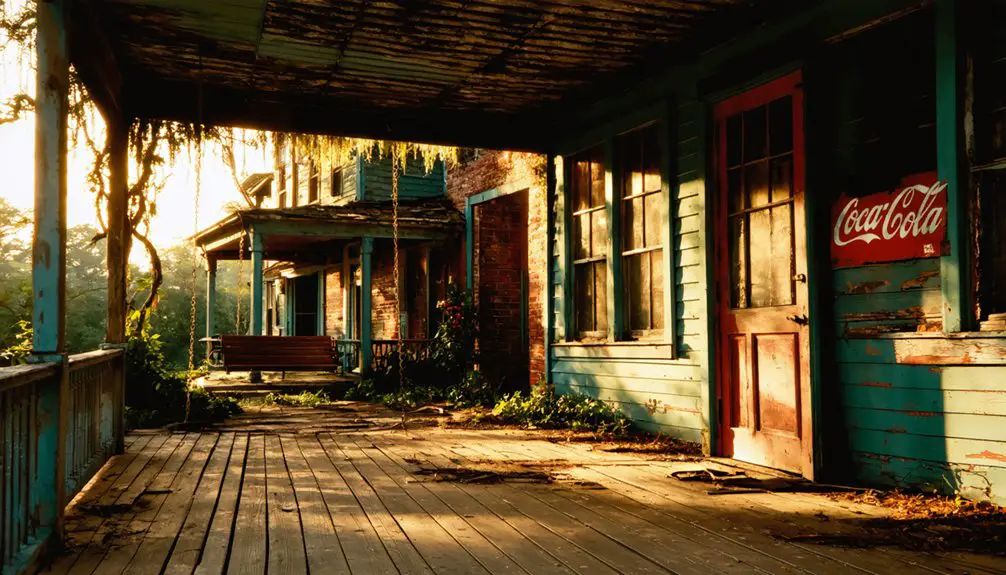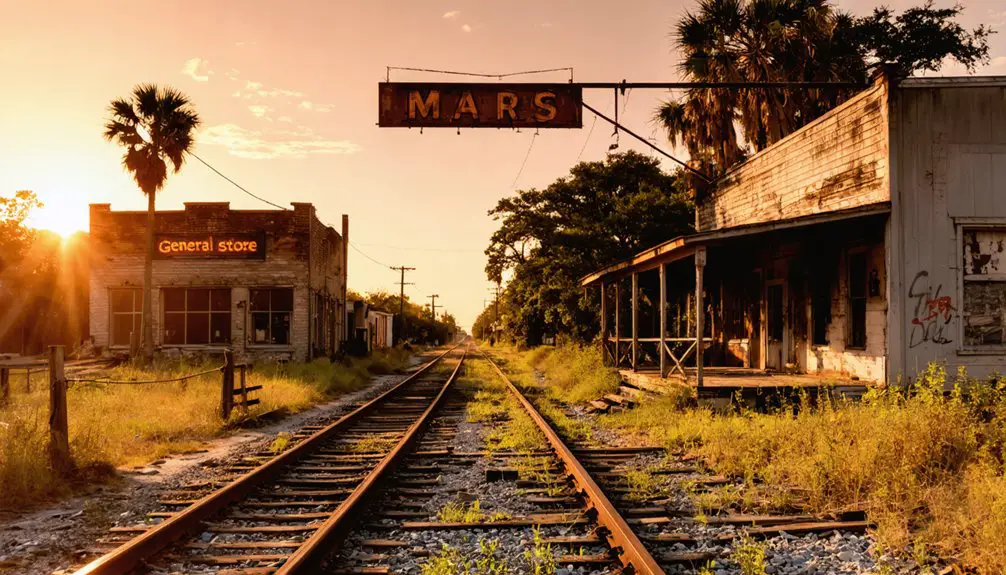You’ll find Mars, Florida near the St. Johns River, where a bustling agricultural settlement once thrived in the early 1900s. The community grew around the Mars Fruit Packing Company, supporting citrus farmers and laborers through railroad connections and trade networks. Natural disasters, including devastating freezes and hurricanes, combined with economic decline and the Great Depression, led to its abandonment. Today, archaeological remains and the Oriole Cemetery reveal fascinating glimpses into this lost pioneer settlement.
Key Takeaways
- Mars developed around the Mars Fruit Packing Company near the St. Johns River as an agricultural community focused on citrus farming.
- The settlement’s economy relied heavily on turpentine extraction, citrus groves, and railroad connections for trade and commerce.
- Natural disasters, including hurricanes and the “Big Freeze” of 1894-1895, severely impacted the community’s agricultural sustainability.
- The closure of Consolidated Naval Stores in 1929 and railroad route changes led to economic decline and population loss.
- Archaeological findings, including military artifacts and the Oriole Cemetery, preserve the ghost town’s historical significance in Florida’s development.
Origins and Early Settlement
While many Florida ghost towns emerged from the railroad boom of the late 1800s, Mars developed specifically around the Mars Fruit Packing Company near the St. Johns River.
You’ll find that community development centered on the arrival of farmers, laborers, and tradespeople who were drawn to the promising agricultural opportunities in the region.
The town’s strategic location and fertile soil made it ideal for citrus farming, which became the backbone of local agricultural practices.
Like many Florida communities of the early 1900s that arose during the land boom era, Mars experienced a period of rapid development and settlement.
Similar to St. Francis, which used ox-drawn carts for transporting goods, Mars relied heavily on basic transportation methods for moving its agricultural products.
You can trace the settlement’s growth to the critical expansion of railroad lines that connected Mars to larger markets, enabling the transport of its agricultural products.
The early community established basic amenities, including a general store and post office, though the population remained modest due to the challenging subtropical environment and competition from neighboring towns.
Pioneer Life and Daily Routines
Once settlers established their homes in Mars, daily life revolved around a carefully structured routine of agricultural labor and community engagement.
You’d find pioneer resilience on display as families tended their orange groves, vegetable gardens, and hen houses, while also managing larger farming operations. Daily chores included preserving food in smokehouses, processing sugar cane syrup, and maintaining essential outbuildings. Like the early settlers of Pumpkin Point, this community worked hard to establish themselves in the Florida frontier. The women spent considerable time maintaining textiles using sad irons and other pressing tools.
From dawn till dusk, pioneer families tended crops and livestock, preserving their harvest to sustain life through challenging seasons.
The community’s lifeblood flowed through its waterways, where steamers delivered mail and supplies.
You’d witness neighbors gathering at the local church, schoolhouse, or boarding house, fostering tight-knit social bonds. When you weren’t working your land, you might’ve traded goods at the general store or picked wild palmetto berries for medicinal use, embodying the self-sufficient spirit that defined these early Florida pioneers.
Economic Activities and Trade

Beyond the daily rhythms of pioneer life, Mars thrived through diverse economic activities that shaped its development.
You’ll find evidence of its bustling past in the remnants of turpentine extraction operations and abandoned citrus groves that once fueled the local economy. Like many Florida frontier towns, Mars participated in the region’s dynamic trade networks through rail connections. The town’s early settlers engaged in a constant struggle against nature while establishing their agricultural and industrial ventures. The decline of Mars followed a pattern seen across Florida where resource depletion led to widespread town abandonment.
- Turpentine workers used Herty cups to collect valuable pine sap, while sawmills processed lumber for regional markets.
- Small-scale farmers cleared dense forests to establish homesteads and citrus groves.
- The railroad served as Mars’ lifeline, connecting it to larger commercial centers.
- Local industries supplied raw materials for secondary manufacturing, including wood products and agricultural goods.
The town’s economy followed the familiar boom-and-bust pattern of Florida settlements, ultimately succumbing to resource depletion and market shifts.
Natural Disasters and Hardships
Despite its promising start as a frontier settlement, Mars faced devastating natural disasters that hastened its decline into abandonment.
You’ll find that hurricane impacts were particularly severe, with storms reaching wind speeds up to 170 mph that destroyed homes, businesses, and essential community structures. These hurricanes brought 16-foot storm surges that flooded the area with saltwater, making much of the land uninhabitable. Like the historic Galveston hurricane disaster, these devastating storm surges proved to be the most lethal aspect of the hurricanes.
Climate challenges further complicated survival in Mars. The “Big Freeze” of 1894-1895 devastated local agriculture, while recurring harsh winters undermined farming efforts. These conditions mirror the fate of Eldora’s citrus industry, which similarly collapsed after severe freezes.
Brutal winters and the historic Big Freeze of 1894 brought farming to its knees, making survival nearly impossible in Mars.
When coupled with the destruction of timber resources from both storms and unsustainable logging practices, these environmental pressures proved too much for the town’s residents. With limited disaster relief available, many families had no choice but to relocate, leaving Mars to fade into history.
The Path to Abandonment
While Mars initially showed promise as a frontier settlement, multiple factors converged to seal its fate as a ghost town. The town’s decline mirrored many similar Florida settlements that couldn’t survive the changing landscape of the early 20th century.
Transportation shifts dealt the first blow as new railroad routes bypassed the community, cutting off essential commerce and passenger traffic. The closure of the Consolidated Naval Stores in 1929 marked another devastating economic setback for the region. Like the devastating Big Freeze of 1894-95 that decimated other Florida settlements, natural disasters hastened the town’s abandonment.
- Young residents left for urban areas offering diverse job opportunities
- The Great Depression eliminated remaining economic prospects
- Railroad changes isolated the settlement from major trade routes
- Declining birth rates and lack of new settlers accelerated depopulation
You’ll find that demographic trends played a significant role, as families sought better opportunities elsewhere. The town gradually dwindled until the last residents departed, leaving behind only memories of what was once a hopeful frontier community.
Archaeological Remains and Artifacts
The archaeological remains of Mars reveal a complex tapestry of 19th and early 20th-century life, from military installations to civilian settlements.
You’ll find six historic buildings still standing on stilts over water, while brick roads and deteriorated staircases lead to rusted military batteries that once guarded Tampa Bay.
Artifact analysis has uncovered fragments of Spanish majolica, porcelain shards, and military items like uniform buttons and ammunition casings.
Archaeological discoveries paint a rich material history through delicate ceramic pieces and military artifacts found scattered across the site.
The Oriole Cemetery stands as a monument to early settler families, with grave markers providing valuable genealogical data.
However, preservation techniques face significant challenges, as many remains lie submerged or hidden beneath vegetation.
The site’s structural remnants, from hospital foundations to military quarters, continue to yield insights into this former settlement’s strategic importance and daily life.
Legacy in Florida’s History

As Florida’s interior regions developed in the late 19th century, Mars emerged as one of many pioneer settlements that shaped the state’s early growth patterns.
You’ll find its cultural significance woven into the broader tapestry of Florida’s pioneer history, reflecting the determination of early settlers who established communities in the state’s rugged interior.
- Represents a classic boom-and-bust cycle common to Florida’s development, where single-industry dependence led to vulnerability
- Preserves community narratives through remaining homesteads and cemeteries that tell stories of pioneer families
- Demonstrates the impact of environmental challenges, including the devastating Big Freeze of 1894-1895
- Serves as a reflection of how changing transportation routes and economic shifts could determine a town’s fate
Frequently Asked Questions
Are There Any Surviving Photographs of Mars During Its Active Period?
You won’t find surviving photographs in historic documentation or visual archives of Mars during its active period, though you might discover hidden collections in local historical societies.
What Happened to the Town’s Original Land Deeds and Property Records?
You’ll find most land ownership records were lost or scattered when the town dissolved, with historical documentation likely absorbed into Charlotte County archives or destroyed through fires and neglect.
Did Any Mars Residents Relocate to Nearby Towns That Still Exist Today?
You’ll find that Mars residents likely moved to surviving towns like Lawtey and Cedar Key, where stable economies and railroad access offered fresh opportunities, though no direct census records confirm specific relocations.
Were There Any Notable Crimes or Mysteries Associated With Mars?
You won’t find any documented unsolved disappearances or notorious residents associated with this location. Historic records show it was a quiet settlement that faded away due to economic and environmental factors.
Did the Town Have Any Unique Cultural Traditions or Annual Celebrations?
You’d find community gatherings centered around harvests and Scandinavian traditions, though specific cultural festivals aren’t well documented. Railroad stops and the post office likely served as hubs for informal celebrations.
References
- https://freepages.history.rootsweb.com/~gtusa/usa/fl.htm
- https://www.journaloffloridastudies.org/0102ghosttowns.html
- https://patchproflorida.com/blog/the-fascinating-history-of-floridas-ghost-towns/
- https://floridatrailblazer.com/category/ghost-towns/page/2/
- https://www.youtube.com/watch?v=8QapC-yk4Bo
- https://floridanature.wordpress.com/2008/10/19/hunting-for-a-ghost-town-in-the-forest/
- https://www.youtube.com/watch?v=ov9YSsKtbDs
- https://frontier-florida.blogspot.com/2017/05/eldora-florida-ghost-town.html
- https://www.youtube.com/watch?v=KwrxybO8tGE
- https://www.youtube.com/watch?v=HQQhO3gbLp8



